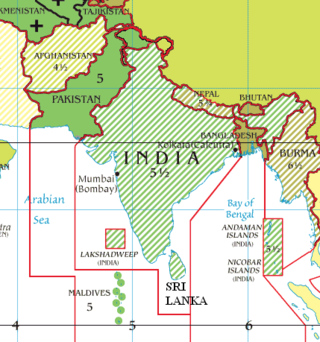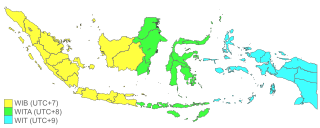
A time zone is an area which observes a uniform standard time for legal, commercial and social purposes. Time zones tend to follow the boundaries between countries and their subdivisions instead of strictly following longitude, because it is convenient for areas in frequent communication to keep the same time.

Japan Standard Time, or Japan Central Standard Time, is the standard time zone in Japan, 9 hours ahead of UTC (UTC+09:00). Japan does not observe daylight saving time, though its introduction has been debated on several occasions. During World War II, the time zone was often referred to as Tokyo Standard Time.

Indian Standard Time (IST), sometimes also called India Standard Time, is the time zone observed throughout the Republic of India, with a time offset of UTC+05:30. India does not observe daylight saving time or other seasonal adjustments. In military and aviation time, IST is designated E* ("Echo-Star"). It is indicated as Asia/Kolkata in the IANA time zone database.

The Alaska Time Zone observes standard time by subtracting nine hours from Coordinated Universal Time (UTC−09:00). During daylight saving time its time offset is eight hours (UTC−08:00). The clock time in this zone is based on mean solar time at the 135th meridian west of the Greenwich Observatory.

Summer time in Europe is the variation of standard clock time that is applied in most European countries in the period between spring and autumn, during which clocks are advanced by one hour from the time observed in the rest of the year, with a view to making the most efficient use of seasonal daylight. It corresponds to the notion and practice of daylight saving time (DST) to be found in some other parts of the world.

Hong Kong Time is the time in Hong Kong, observed at UTC+08:00 all year round. The Hong Kong Observatory is the official timekeeper of the Hong Kong Time. It is indicated as Asia/Hong_Kong in the IANA time zone database.
Singapore Time (SGT), also known as Singapore Standard Time (SST), is used in Singapore and is 8 hours ahead of UTC (UTC+08:00). Singapore does not observe daylight saving time.

UTC+08:00 is an identifier for a time offset from UTC of +08:00.

South African Standard Time (SAST) is the time zone used by all of South Africa as well as Eswatini and Lesotho. The zone is two hours ahead of UTC (UTC+02:00) and is the same as Central Africa Time. Daylight saving time is not observed in either time zone. Solar noon in this time zone occurs at 30° E in SAST, effectively making Pietermaritzburg at the correct solar noon point, with Johannesburg and Pretoria slightly west at 28° E and Durban slightly east at 31° E. Thus, most of South Africa's population experience true solar noon at approximately 12:00 daily.

UTC+07:00 is an identifier for a time offset from UTC of +07:00. In ISO 8601 the associated time would be written as 2024-01-06T18:36:14+07:00. It is 7 hours ahead of UTC, meaning that when the time in UTC areas is midnight (00:00), the time in UTC+07:00 areas would be 7:00 in the morning.

Australia uses three main time zones: Australian Eastern Standard Time, Australian Central Standard Time and Australian Western Standard Time.

The time in China follows a single standard time offset of UTC+08:00 based on the National Time Service Center of Chinese Academy of Sciences located in Mount Li, Lintong District, Xi'an City, Shaanxi Province, even though the country spans almost five geographical time zones. The official national standard time is called Beijing Time domestically because based on 120th meridian east that Beijing City is located, and China Standard Time (CST) internationally. Daylight saving time has not been observed since 1991. China Standard Time (UTC+8) is consistent across Mainland China, Hong Kong, Macau, Taiwan, Philippines, Singapore, Brunei, Mongolia, etc.

Time in Brazil is calculated using standard time, and the country is divided into four standard time zones: UTC−02:00, UTC−03:00, UTC−04:00 and UTC−05:00.
Thailand follows UTC+07:00, which is 7 hours ahead of UTC. The local mean time in Bangkok was originally UTC+06:42:04. Thailand used this local mean time until 1920, when it changed to Indochina Time, UTC+07:00; ICT is used all year round as Thailand never observed daylight saving time. Thailand shares the same time zone with Vietnam, Cambodia, Laos, Christmas Island, and Western Indonesia.

The Republic of Indonesia, a country located in Southeast Asia, comprise many islands, prompting the government to recognise three time zones. Western Indonesia Time is seven hours ahead (UTC+07:00) of the Coordinated Universal Time (UTC), used in the islands of Sumatra, Java, and the western half of Kalimantan. Central Indonesia Time is eight hours ahead (UTC+08:00), used in the eastern half of Kalimantan, as well as all of Bali, the Lesser Sunda Islands, and Sulawesi. Eastern Indonesia Time is nine hours ahead (UTC+09:00), used in the Maluku Islands and Western New Guinea.
The UTC offset is the difference in hours and minutes between Coordinated Universal Time (UTC) and local solar time, at a particular place. This difference is expressed with respect to UTC and is generally shown in the format ±[hh]:[mm], ±[hh][mm], or ±[hh]. So if the time being described is two hours ahead of UTC, the UTC offset would be "+02:00", "+0200", or simply "+02".

National Standard Time is the official time zone in Taiwan defined by an UTC offset of +08:00. This standard is also known as Taipei Time (臺北時間), Taiwan Time (臺灣時間) or Taiwan Standard Time (TST).

Portugal has two time zones and observes daylight saving time. Continental Portugal and Madeira use UTC+00:00, while the Azores use UTC–01:00. Daylight saving time is observed nationwide from the last Sunday in March to the last Sunday in October, when continental Portugal and Madeira advance one hour to UTC+01:00, and the Azores advances one hour to UTC+00:00.
Reunified Vietnam follows Indochina Time (ICT), which is seven hours ahead of UTC, ICT is used all year round as Vietnam does not observe daylight saving time. Vietnam shares the same time zone with Thailand, Cambodia, Christmas Island, Laos, and Western Indonesia.
Time in the Kingdom of the Netherlands is denoted by Central European Time during the winter as standard time in the Netherlands, which is one hour ahead of coordinated universal time (UTC+01:00), and Central European Summer Time (CEST) during the summer as daylight saving time, which is two hours ahead of coordinated universal time (UTC+02:00). The Caribbean Netherlands – which consist of the islands of Bonaire, Sint Eustatius and Saba – all observe Atlantic Standard Time (AST) year-round, which is four hours behind coordinated universal time (UTC−04:00).














